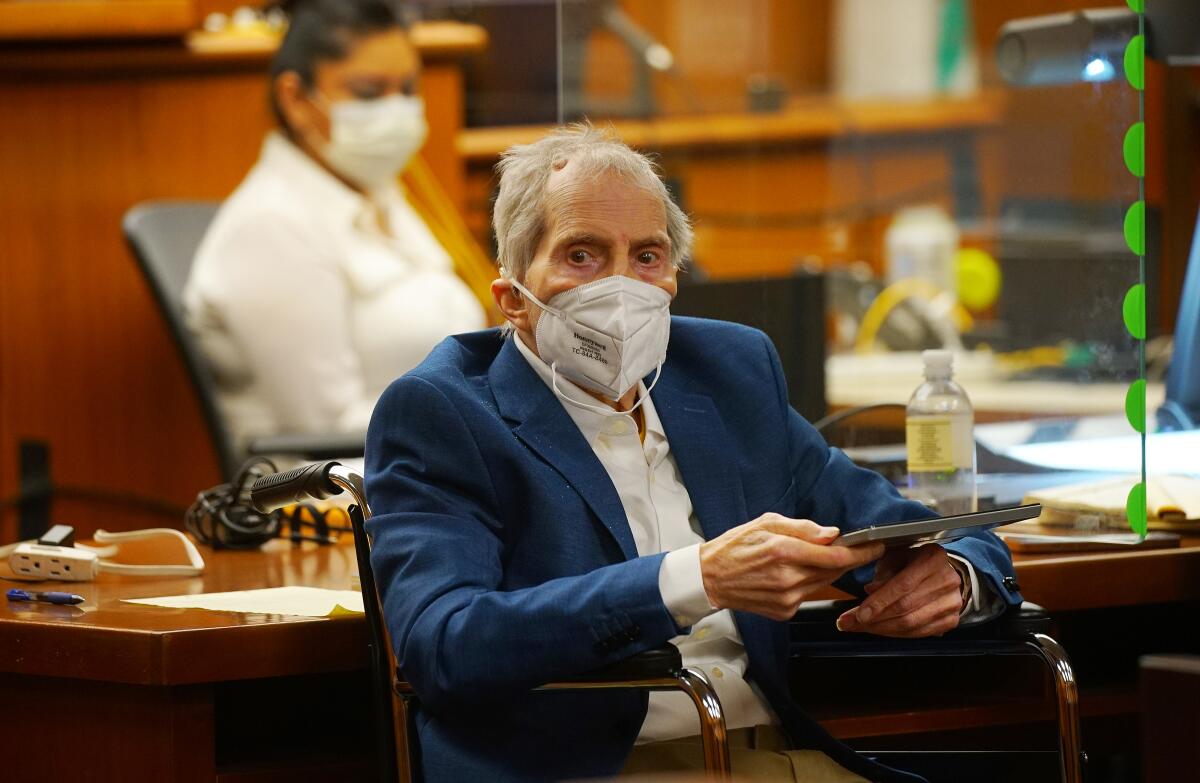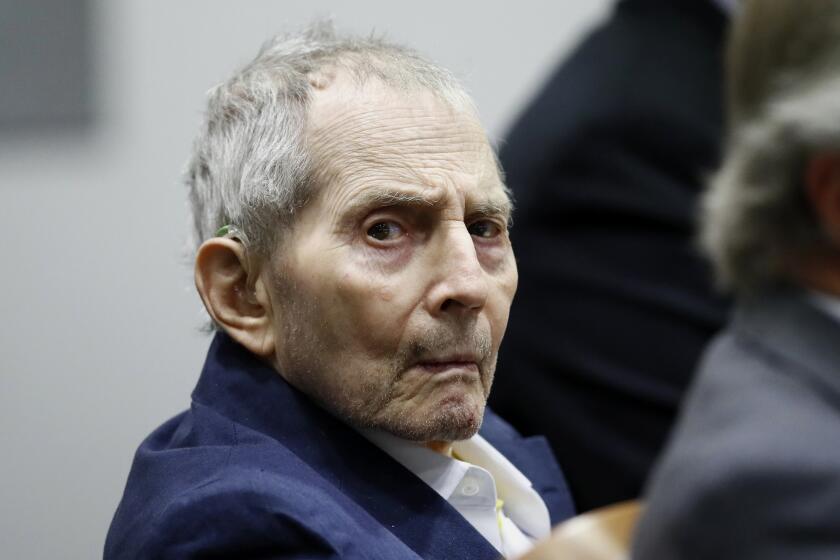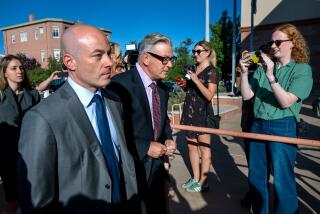Robert Durst murder trial opens — again — with Benedict Canyon shooting scene

- Share via
Susan Berman was careful to keep her doors and windows locked, but she had no fear of her close friend Robert Durst when he showed up at her Benedict Canyon home late one night in December 2000, so she let him in, a prosecutor told jurors on Tuesday.
“She turned around, she took a few steps, and he basically blew her brains out,” Deputy Dist. Atty. John Lewin said in his opening statement at Durst’s murder trial.
Fourteen months after the trial was cut short by the COVID-19 pandemic, it started over Tuesday at a Los Angeles County courthouse in Inglewood.
Ten witnesses testified in early 2020, but memories fade, so Superior Court Judge Mark Windham invited prosecutors and defense attorneys to reprise their opening statements.
Durst, a gaunt, 78-year-old Manhattan real estate heir, sat hunched in his wheelchair as the prosecutor accused him of shooting Berman in the back of the head in a plot to cover up the alleged 1982 murder of his first wife, Kathleen Durst, in New York.
Durst has not been charged with murdering his wife, whose body was never found after she disappeared. But Lewin said prosecutors would nonetheless show that Durst killed her so that jurors could understand the motive behind his murder of Berman.
After a 14-month pandemic-induced hiatus, Robert Durst will finally stand trial for the 2000 murder of Susan Berman.
Durst has said that when Berman was killed, he was aware that New York investigators had reopened the investigation of his wife’s murder and were following new leads. Prosecutors say he feared that Berman, a friend from their days as students at UCLA in the 1960s, would implicate him.
Lewin told jurors Tuesday that Berman knew her killer and let him into her house because she trusted him.
“There was no ransacking,” he said. “There was no struggle. Nothing, in fact, was taken that day, other than Susan’s life. Her purse with credit cards, with ID and cash, was on the kitchen counter.”
Burglars, he added, steal things. “They don’t just walk in and execute somebody and leave.”
Five years after HBO’s ‘The Jinx,’ Durst will stand trial in the 2000 killing of Susan Berman at her Benedict Canyon home.
Defense attorney Dick DeGuerin is expected in his opening statement Wednesday to argue that Durst did not kill Berman.
When the trial opened last year, DeGuerin said Durst discovered Berman’s dead body at the house and fled in panic. DeGuerin also acknowledged that Durst wrote an anonymous letter alerting Beverly Hills police to Berman’s “cadaver” at the house.
Durst had previously denied writing the “cadaver note” in video interviews that the prosecutor played Tuesday for the jury. Lewin showed jurors a 2012 video of Durst saying that “only the killer could have written” the note to police.
“As with a lot of the evidence in this case,” Lewin said, “it’s going to come right from the defendant’s own mouth.”
One of the key sources of prosecutors’ video evidence in the trial is likely to be excerpts from the 20 hours of interviews Durst gave for the HBO documentary series “The Jinx: The Life and Deaths of Robert Durst.”
To refresh jurors’ memory of testimony they heard least year, Lewin played recordings of witnesses who recalled that in the months before her 1982 disappearance, Kathleen Durst was distraught over her husband’s alleged emotional abuse and physical violence.
Lewin urged jurors not to conflate the “extremely frail” man now on trial with the one accused of killing his wife and Berman.
“That’s not who Robert Durst was in 1982,” the prosecutor said. “It’s not who he was in 2000.”
Lewin played video of Durst saying his marriage around 1981 featured “arguments, fighting, slapping, pushing, wrestling.” Another video played by the prosecution showed Durst telling filmmakers years later that he couldn’t remember whether he dragged his wife out of their house by the hair or yanked a clump of hair out of her head.
“Either one is close enough,” Durst said in the interview. “The hair-pulling wasn’t even the worst.”
Lewin also played video of Durst saying he and his wife had a “pushing, shoving argument” in the hours before she disappeared. The prosecutor alleged that Durst killed his wife that night at their lakeside cottage in South Salem, N.Y., and “got rid of her body” but left unclear what evidence he would produce to back up the allegation.
The next day, Lewin said, Berman provided Durst with an alibi, impersonating his wife in a phone call to Kathleen Durst’s boss, saying she was too sick to report to work.
Eighteen years later, Berman told Durst — falsely — that the investigators who had reopened the murder case wanted to interview her.
“That is the move that cost her her life,” Lewin told the jury. “That is what sealed her fate. That is what got her the bullet in the back of her head.”
More to Read
Sign up for Essential California
The most important California stories and recommendations in your inbox every morning.
You may occasionally receive promotional content from the Los Angeles Times.













